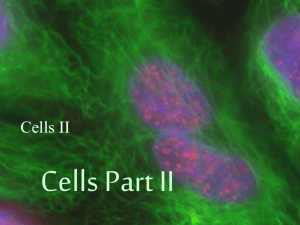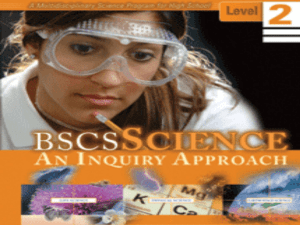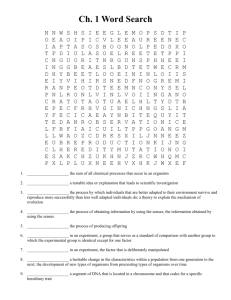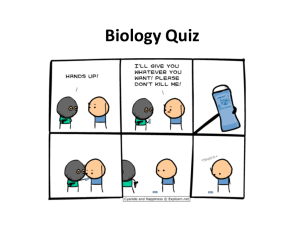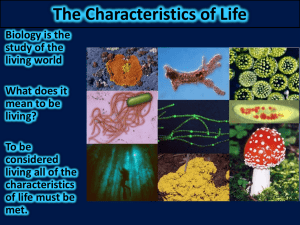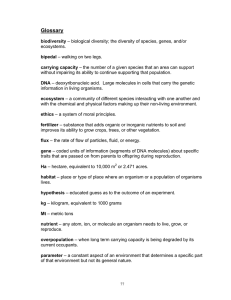Information Transfer Energy for Life Basic themes of biology include evolution, information transfer,
advertisement
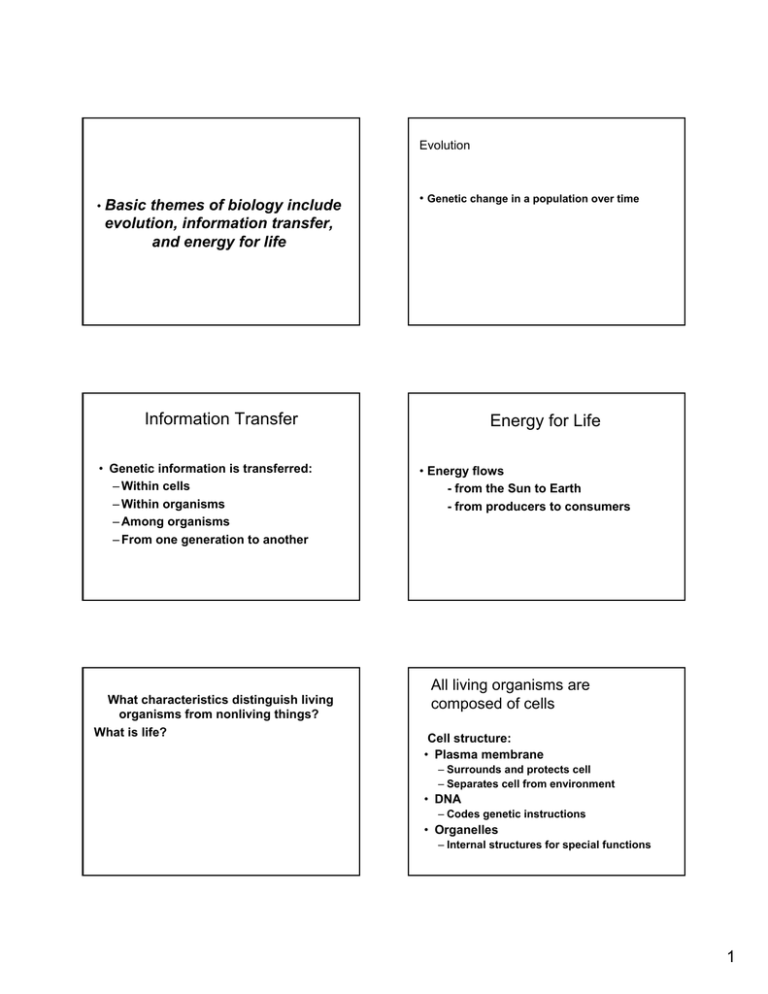
Evolution • Basic themes of biology include evolution, information transfer, and energy for life • Genetic change in a population over time Information Transfer • Genetic information is transferred: – Within cells – Within organisms – Among organisms – From one generation to another What characteristics distinguish living organisms from nonliving things? What is life? Energy for Life • Energy flows - from the Sun to Earth - from producers to consumers All living organisms are composed of cells Cell structure: • Plasma membrane – Surrounds and protects cell – Separates cell from environment • DNA – Codes genetic instructions • Organelles – Internal structures for special functions 1 Two Types of Cells • Prokaryotic cells – Bacteria and archaea – Single celled organisms – No membrane-bound organelles • Eukaryotic cells Organisms Grow and Develop • Biological growth – Increases size and/or number of cells • Development – Changes that take place during an organism’s lifetime – Organelles enclosed by membranes – Nucleus contains DNA Organisms Regulate Their Metabolic Processes • Metabolism – All the chemical activities of the organism Organisms Respond to Stimuli • Stimuli – Physical or chemical changes in the internal or external environment • Homeostasis – Mechanisms regulate and balance the internal environment Organisms Reproduce • Asexual reproduction – Low genetic variability What are the hierarchical levels of biological organization? • Sexual reproduction – High genetic variability 2 The Hierarchy of Biological Organization What is the importance of information transfer to living organisms? Ecological Hierarchy DNA • Transmits information from one generation to the next • Codes for proteins Evolution: The Unifying Concept of Biology • Theory of Evolution – Explains changes in populations over time Information is Transmitted • Chemical and electrical signals – Proteins – Hormones – Neurons (nerve cells) – Neurotransmitters Organizing the Study of Life • Systematics – Study of organisms and their evolutionary relationships • Taxonomy – Science of naming and classifying organisms • Species – Populations capable of breeding with one another 3 Taxonomic Classification is Hierarchical Taxonomic Classification Domain Kingdom Phylum Class Order Family Genus Species Three Domains: Bacteria Archaea Eukarya Light energy Energy Flow Six Kingdoms: Heat Bacteria Archaea Protista Plantae Animalia Fungi Food Consumer (caterpillar) Consumer (robin) Producer (plant) Tree of Life Plant litter, wastes Common ancestor of all organisms Soil Fig. 1-9, p. 12 Autotrophs • Producers (autotrophs) – Make their own food – Transform light energy to chemical energy through photosynthesis • Photosynthesis CO2 + water + light → sugars + oxygen Dead bodies Decomposers (bacteria, fungi) Fig. 1-13, p. 14 Heterotrophs • Consumers (heterotrophs) use energy stored by producers through cellular respiration sugars + oxygen → CO2 + water + energy • Decomposers (heterotrophs) break down wastes and dead organisms 4 NUTRITION Chemicals: Nutrients Some used as raw materials OTHER ACTIVITIES • Homeostasis • Movement of materials in and out of cells • Growth and development • Reproduction SYNTHESIS Manufacture of needed materials and structures organic compounds Some used as fuel CELLULAR RESPIRATION Biological process of breaking down molecules • Carbohydrates – Sugars & starches – Energy • Lipids – Fats (animal), oils (plant) – Energy, cell membrane – Hormones Energy Fig. 1-12, p. 14 Chemicals: organic compounds • Proteins – Made of amino acids – Multiple functions – Enzymes – speed up chemical reactions • Nucleic acids – DNA, RNA – Make proteins Organelles Cells & Organelles • “Little organs” • Nucleus – Largest – Contains DNA • Rough ER – Contains ribosomes – Make proteins • Smooth ER – Makes lipids Mitochondria • Lysosome – Digestive enzymes – Molecules, dead organelles • Produce ATP = energy • Contain DNA • 100-1000s per cell • Majority of organelles inherited from mother 5 Plasma Membrane • Cell membrane (edge) • Special lipid = phospholipid – Keeps organelles inside Genetics • Cells – Units of life • DNA – Deoxyribonucleic acid – Molecule of genes (Units of heredity) • Genome – All DNA in a cell DNA • 4 bases (nucleotides) –A –C –G –T Gene • Segment of DNA • Determines amino acid sequence of a protein • Protein Æ physical characteristics – Phenotypes • Sequence of bases • Genes are DNA segments • Genes Æ proteins • RNA – Helps to make proteins Nucleotide Chromosomes • Single unit of DNA – Deoxyribose sugar – Phosphate group – Nitrogenous base • 4 nitrogenous bases • • • • Threads of DNA 46 in human cells 3 billion nucleotides ~21,000 genes – Adenine (A), Guanine (G) – Cytosine (C), Thymine (T) – A, G = Purines – C, T = Pyrimidines 6 Mitosis Mitosis? Mitosis: division of cells that results in daughter cells with the same the genetic information that the original cell had. • Division of somatic (body) cells • Growth and repair!!! 46 46 46 Diploid 2n Diploid 2 n Mitosis • Replicated chromosomes align at equator • 2 new cells form Meiosis Meiosis: division of cells that results in daughter cells with one-half of the genetic information that the original cell had. 23 46 Diploid 2n 23 23 23 Haploid n 7

